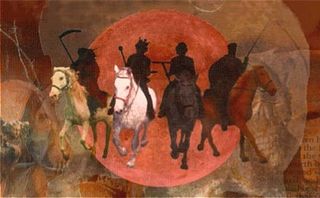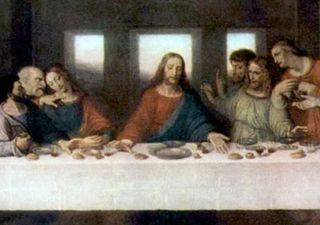 At the time I did my previous post on Fr. Roy Bourgeois, I did not have access to the letter to his religious superiors in which he was said to make five argument for women priests. I would like to thank those who were able to find it and send me a link. It can be found in its entirety here.
At the time I did my previous post on Fr. Roy Bourgeois, I did not have access to the letter to his religious superiors in which he was said to make five argument for women priests. I would like to thank those who were able to find it and send me a link. It can be found in its entirety here.
In this post I would like to look at the arguments proposed by Fr. Bourgeois and see whether they are sound. I will offer each of his arguments, in his own words, and then respond to it so that this post takes the form of what you might call a literary debate.
Let us begin.
(1) As Catholics, we believe that we were created in the image and likeness of God and that men and women are equal before God. Excluding women from the priesthood implies that men are superior to women.
It is true that men and women are created in the image and likeness of God. It is also true that there are many senses in which men and women are equal before him. They are equally dependent on his grace. They have equal access to salvation. He loves them equally. He has endowed them with equal dignity. He had endowed them with equal responsibility and will hold them equally accountable. And in a generic and ultimate perspective they may validly be said to be equal before him.
This does not mean that they are homogenous in all respects, however. It is clear that there are differences between the sexes that are rooted in nature and that are not simply the product of nurture. Though the feminist movement has long tried to portray many gender differences traditionally regarded as innate as being merely the product of culture, numerous recent scientific studies, as well as common sense and the common experience of mankind, have shown that they are, in fact, innate. Even many in the feminist movement now admit this.
Some innate gender differences are virtually too obvious to be rationally denied by anyone. To begin with overt physical differences, men are, on average, taller and weigh more than women. They are physically stronger, particularly in the upper body. They grow facial hair. Women are on average smaller and lighter. They have less physical strength, particularly in the upper body. And they grow functional breasts. Moving to somewhat less obvious but still statistically demonstrable sex differences, women have longer life spans (which, to my mind, means they get the long end of the stick in an extremely important way that I am personally envious of). Women also have greater verbal intelligence. Men have greater spatial intelligence. There are also emotional differences. Women tend to be more nurturing. Men tend to be more willing to assume greater risk.
While many of these differences are statistical in nature (i.e., they are true of the genders on average, though they may not be true of a specific man or a specific woman; thus some women are taller than some men, some men live longer than some women), there are some sex differences that are absolute. For example: Only men can be fathers; only women can be mothers. There are no male mothers and no female fathers—not in the literal sense of these terms.
The fact that there are innate sex differences in humans means that one cannot reduce the question of ordination to the priesthood to the question of equality before God. While the sexes do have equality before God (certainly in the general and ultimate sense), the specific differences between them mean that they are—statistically or absolutely—more suited to certain roles. Statistically, men are better protectors by virtue of their strength and risk tolerance; women are better providers of childcare by virtue of their nurturing capacity and ability to nurse. Absolutely: Men are better fathers; women are better mothers.
The Catholic Church proposes that God has chosen to only authorize the ordination of men to the priesthood. Why he may have chosen this is a matter of speculative theology on which the Church has not pronounced (certainly not definitively). It may be that the priesthood displays a form of fatherhood that makes the male gender absolutely suited for it in a way women are not. It may be that the male gender displays certain characteristics that, statistically rather than absolutely, make men better suited to the priesthood and God has chosen them due to this fact. These are matters of theological speculation, however.
What is clear is that one cannot simplistically posit male/female equality as an argument that women should be ordained to the priesthood. Equality before God does not mean absolute identicality between the sexes, and if it does not mean that then it does not mean possessing identical functions in all situations—ecclesiastical or otherwise. It thus does not follow that saying God has chosen only men for the priesthood implies that men are superior—any more than it implies that God has chosen certain men for the priesthood means that these men are superior to other men. We each have our own gifts and callings, and these are not identical.
Thus this argument is inadequate. It does not prove what it attempts to.
(2) Catholic priests say that the call to be a priest is a gift and comes from God. How can we, as men, say: “Our call from God is authentic, but your call, as women, is not”? Who are we to reject God’s call of women to the priesthood? I believe our Creator who is the Source of life and called forth the sun and stars is certainly capable of calling women to be priests.
In my previous post I responded to Fr. Bourgeois’ statement regarding God as the one “who is the Source of life and called forth the sun and stars” being able to call women to the priesthood. As I pointed out there, this is fatuous grandstanding. We all acknowledge that God is omnipotent and can do whatever he chooses. But asserting that he is able to make a particular choice does not provide evidence that he has made a particular choice. As we noted then, God can make pink unicorns with sparkly eyes and rainbow manes, but if you want to claim that he has done this, you need to produce evidence for the claim, not merely assert God’s ability to do it.
Turning to the first part of Bourgeois’ second argument, it is clear that this is overly facile reasoning. This will be clear if we simply change the context of the argument, from being why men rather than women should be ordained to the priesthood to why certain men rather than other men should be ordained. Making the necessary substitutions, what would we make of an argument that says:
How can we, as certain men, say: “Our call from God is authentic, but your call, as other men, is not”? Who are we to reject God’s call of other men to the priesthood?
Unless we are prepared to accept that God has called all men without exception to the priesthood then we must be prepared to accept that he has called some and not others. Given that some men are manifestly not qualified to serve in this role (e.g., pedophiles—just to name an obvious and incontrovertible example), it would appear that his choice is rational. But if God may rationally choose between one group and another in whom he calls to priestly ministry then one cannot rely on an argument of the form Bourgeois has presented. It may identify women as a particular class and ask how it is that God might not choose them for the priesthood, just as he does not choose many men (myself included), but the appeal to pity that Bourgeois proposes (“How can we, as X, say that our call is authentic but yours, as Y, is not?”—in other words: “Have pity on Y; they are no different than we as X”) does not provide any reasons why women should be regarded as a class indistinguishable from men—or from called men. Once again, Bourgeois has failed to provide evidence for why these two groups should be treated as the same in terms of ordination.
It also should be noted that his reference to the priesthood being a divine gift actually undermines his case since, as we saw in my previous post, the gratuity of a divine gift implies that no one has a right to the priesthood and thus no one can claim injustice if they are not called to it.
(3) We are told that women cannot be priests because Jesus chose only men as apostles. As we know, Jesus did not ordain anyone. Jesus also chose a woman, Mary Magdalene, to be the first witness to His resurrection, which is at the core of our faith. Mary Magdalene became known as “the apostle to the apostles.”
Here Bourgeois finally engages the Church’s actual position regarding women’s ordination. As we saw in my previous post (and please do check it out for more detail), the Church recognizes that Christ chose only men to be his apostles and feels bound to follow this decision of her Lord and God today in the selection of ordained ministers.
Bourgeois offers three rejoinders to this argument, each of which is quite weak:
a) “As we know, Jesus did not ordain anyone.”
We know nothing of the kind. If by “ordination” you mean “sacramental laying on of hands for purposes of placing one in the priesthood” then we have no mention one way or another of whether Jesus did this. As the gospels themselves record (John 21:25), Jesus did many things that are not recorded in them. One of them might have been such an ordination-by-laying-on-of-hands ceremony.
If such a ceremony never occurred, however, this deals only with the means by which Jesus conducted ordination (the placing of an individual in a specific ordo or order of ministerial service). He most definitely did ordain, through hands or another means, his apostles to service as priests. This is, in fact, an infallibly defined dogma. The Council of Trent defines that by telling the apostles to “do this [the Eucharist] in memory of me” he thereby commissioned them to function as priests. This commission entails an ordination, whether it was performed that minute by his words alone or subsequently by the imposition of his hands.
b) “Jesus also chose a woman, Mary Magdalene, to be the first witness to His resurrection, which is at the core of our faith.”
It is noteworthy that Mary Magdalene was one of the first witnesses (not the first, as Bourgeois says, but one of a group) to Christ’s resurrection. This has notable apologetic value since women were not then considered to be trustworthy witnesses in court, yet the gospels record women as the first witnesses—contrary to what one would make up if one were fabricating the accounts. The extent to which Jesus “chose” Mary Magdalene and the other women (as opposed to allowing the action of their own free wills in this situation) is more open to discusion. However, no one has historically seen the role of Mary Magdalene as an indication that she served ordained ministry as a priest. Bourgeois is simply grasping at straws.
c) “Mary Magdalene became known as ‘the apostle to the apostles.’”
To the extent this terminology has been used for Mary Magdalene, it has always been understood in an analogous way. It has never been seriously entertained that Mary Magdalene was a literal apostle or an ordained priest. Women today may serve such analogous roles without implying literal ordination or a right thereto.
(4) A 1976 report by the PontificalBiblical Commission, the Vatican’s top Scripture scholars, concluded that there is no valid case to be made against the ordination of women from the Scriptures. In the Episcopal, Methodist, Lutheran, United Church of Christ, Presbyterian and other Christian churches, God’s call of women to the priesthood is affirmed and women are ordained. Why not in the Catholic church?
As we saw in my previous post, Bourgois is misrepresenting the document he mentions. A look at the full text of his letter only strengthens this appraisal. First, the Pontifical Biblical Commission does not represent “the Vatican’s top Scripture scholars.” It represents a number of biblical scholars, periodically chosen an rotated, who have a notable degree of esteem by the Holy See, but it does not, at any given moment, represent “the best of the best.” Second, the 1976 document in question was not an official document of the PBC. It was a draft document that was leaked to the press without authorization. It has no official status. Third, it did not conclude that “there is no valid case to be made against the ordination of women from the Scriptures.” Instead, it concluded that some scholars think there is such a case to be made from Scripture alone, some think that there is not, and that the drafters of the document in question think the question is hard to settle from Scripture alone. Bourgeois is thus grossly misrepresenting both the nature and the conclusions of the draft document.
Regarding the statement that women are ordained to the priesthood in various Protestant denominations, several responses may be in order:
a) If we wish to play a numbers game, the Protestant denominations in question represent less than a quarter of global Christendom. Why should the choices of such a minority be determinative for the majority?
b) Bourgeois seems to be misinformed regarding the practice of these groups. Most of them do not recognize the priesthood—or certainly not a sacramental priesthood—at all. So why should they be determinative of a question that involves an apples-to-oranges comparison?
c) They are non-Catholic groups and, whatever merits they may have, they cannot be regarded from a Catholic perspective as being guided by God in the same way that the Catholic Church is. Why should their ordination practices trump that of the Catholic Church, which is—from a Catholic perspective—fully guided by God in these matters?
As to Bourgeois’ query, “Why not in the Catholic church?” see the rest of this post and the previous one.
(5) The Holy Scriptures remind us in Galatians 3:28, “There is neither male nor female. In Christ Jesus you are one.” Furthermore, the Second Vatican Council’s Pastoral Constitution on The Church in the Modern World states: “Every type of discrimination … based on sex. .. is to be overcome and eradicated as contrary to God’s intent.”
Here Bourgeois demonstrably misrepresents both St. Paul and the Second Vatican Council.
While St. Paul may be fairly characterized as stressing the equality of men and women regarding their access to salvation, Christ’s love for them, etc., this cannot be construed as an endorsement of them playing identical roles in Church. This is made extremely clear from some of the things St. Paul says elsewhere in his writings, such as:
I permit no woman to teach or to have authority over men; she is to keep silent. For Adam was formed first, then Eve; and Adam was not deceived, but the woman was deceived and became a transgressor. Yet woman will be saved through bearing children, if she continues in faith and love and holiness, with modesty [1 Tim 2:12-15].
This passage has significant implications for the ability for women to assume the priesthood.
Even if one (wrongly to my mind) questions the Pauline authorship of 1 Timothy, the book is still part of inspired Scripture and cannot simply be set aside.
In any event, Paul’s other writings contain multiple references to men and women functioning differently in church, however equal they may be from the ultimate perspective before God. One cannot represent Paul’s “one in Christ” statement as an endorsement of women’s ordination.
Neither can one represent Vatican II’s condemnation of discrimination as such. Had the Council meant to endorse women’s ordination, it would have done so. The rejection of unjust discrimination—which is what we are talking about—does not entail the rejection of sexual differences or roles. It is not possible to give a serious reading to Vatican II and take it as endorsing women’s ordination.
The arguments used by Fr. Bourgeois thus come up lacking. If he proposes that the Church change its theology (which it can’t do, given that this is an infallible teaching) then the burden of proof is on him, and he has not presented any arguments that survive even a cursory examination.
Let us keep him, and all those he misleads, in prayer.
 A page on CNN’s web site is headlined:
A page on CNN’s web site is headlined: According to something on Yahoo called “Shine,”
According to something on Yahoo called “Shine,” From the Code of Canon Law (CIC 1983):
From the Code of Canon Law (CIC 1983):




